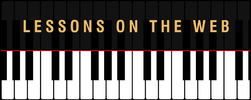|
Improve your overall technique by practicing these five things. 1. Work on your fingering: People often underestimate the importance of fingering. Fingering is what allows you to play fluidly up and down the piano. Music is often composed of scalar patterns, arpeggiated chords, finger crosses and other passages which require careful fingering. Play through passages slowly and try to come up with the best fingering. The rule of thumb is that you should never “run out of fingers”. So if you have a scalar passage, you should generally use the fingering of that scale so that you can play the entire passage without having to move your hand in any uncomfortable way. Not only is it uncomfortable, but it will break up the melodic phrasing, causing it to sound awkward. There are many resources out there so that you can work on your fingering. A scales and arpeggios book will help you develop proper fingering with scalar and arpeggiated passages. There are specific technique books out there which will have exercises specifically targeted towards fingering. Here is an easy piano technique book you can use to get started.
2. Practice your scales: Didn’t we kind of cover this in number one? Well yes, but there are more benefits to learning your scales than just fingering. A scale is really all of the notes that exist in a key signature put into alphabetical order starting from the tonic note to the next tonic note. Knowing each scale and where the sharps or flats are placed will assist you greatly in playing music in different keys. Scales and Arpeggios Book 3. Practice your chords and cadence patterns: In addition to scales and arpeggios; there are a lot of chords and candential patterns in music. You want to know your major chords, minor chords, diminished chords, augmented chords, major 7th, minor 7th, and dominant 7th chords in all inversions. For those of you who may not know, a cadence is a chord pattern which is commonly used in music. Knowing different types of cadences in every key is recommended. Learn about I,IV,V,I ; I, ii, V, I ; and I ii vii0 I chord progressions and learn to play those using proper voice leading. If you want to learn more about chord progressions and cadences, please check out my online Academy. 4. Sight Read every day: You should sign read almost every time you practice. When sight reading, it is recommended that you read something just under your current playing level. However, you don't want to pick something that is too easy as it won't challenge you and your sight reading won't improve as much. When first starting to read, you may want to get a lesson book for beginners that you have never went though before. Remember, for it to be sight reading; it needs to be a piece of music you have never seen or practiced before. Check out this sight reading book series if you want to work on your sight reading. 5. Practice your articulations: What are articulations? Well they tell you HOW to play a certain note. Do you play the note short and detaches, long and connected, or with more emphasis? The articulation will tell you the answer. Practice playing passages of music with different articulations. Beethoven's and Mozart's music makes very good use of articulations, so learning some of their easier pieces to start is advisable. That's it for now! More articles on the way so check back here for more. Check out my Online Music Academy Check out my FREE Piano Lesson Gallery |
AuthorMost blogs written by Archives
June 2020
Categories
All
|


 RSS Feed
RSS Feed